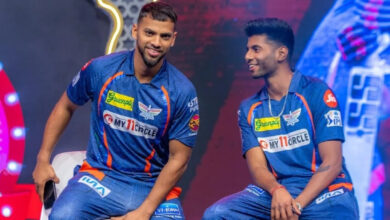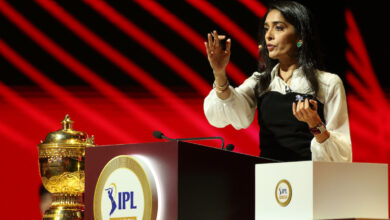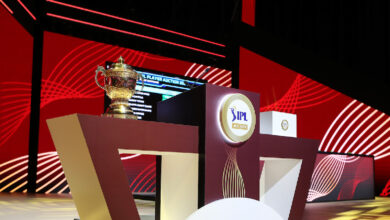Ben Shelton Masters a Tricky Fifth Set at the Australian Open. Holger Rune Does Not

Two young tennis players born just six months apart were in different arenas but in the same predicament Monday: trying to figure out how to prevail in a fifth set.
Neither Holger Rune nor Ben Shelton had been this far at an Australian Open.
Shelton, a 20-year-old American lefty with a friendly manner and an unfriendly serve, had never played in the Australian Open at all until this month, not even as a junior.
But both powerful and hungry youngsters were on the brink of reaching the quarterfinals on opposite ends of the vast concourse at Melbourne Park that leads from the main court, Rod Laver Arena, to John Cain Arena.
Rune, a 19-year-old from Denmark who entered the tournament ranked 10th in the world after a breakthrough 2022 season, was in Laver Arena facing No. 5 seed Andrey Rublev in one of the featured matches of the day.
The unseeded Shelton was somewhere closer to off-Broadway in Cain Arena facing J.J. Wolf, another unseeded American aiming for a breakthrough.
Laver Arena was full. Cain Arena was not, with only a few fans seated on its sunny side on a warm yet hardly torrid day.
But there were still shouts, roars and plenty of shifts in momentum in both venues before both matches arrived at a decisive fifth set, part of the learning curve for a professional men’s tennis player.
Rune and Shelton had each played just one five-setter before arriving in Melbourne. Rune cramped in his five-set defeat to Kwon Soon-woo of South Korea at last year’s Australian Open; Shelton ran out of steam in his five-set defeat to Nuno Borges of Portugal at last year’s U.S. Open, his only previous major tournament.
“Five sets in the heat, I barely survived,” Shelton said. “My fitness wasn’t near what I needed it to be at. So, I’ve worked really hard these last five or six months to get to where I want to be.”
He has hired Daniel Pohl, a German fitness trainer who has worked with Naomi Osaka. Shelton was smart Monday: toning down his natural exuberance early against Wolf to save fuel; dominating the fourth-set tiebreaker; jumping out to a quick lead in the fifth set; and then building on it to win, 6-7 (5), 6-2, 6-7 (4), 7-6 (4), 6-2.
Wolf, 24, never broke Shelton’s serve in five sets, getting only two break points. Now, Shelton will play in another all-American match, against Tommy Paul, 25, in the first Grand Slam quarterfinal for both. Paul, already an established threat on the tour with victories over Rafael Nadal and Carlos Alcaraz, advanced with a victory, 6-2, 4-6, 6-2, 7-5, over No. 24 seed Roberto Bauta Agut of Spain.
There is a gentle side to Shelton, much gentler than his running forehand, while Rune stalks the court with his long, elastic strides like a predator in search of the next meal.
Still a teenager, Rune is already an imposing, intimidating physical presence, with rippling muscles in his legs and nervous energy as he adjusts his backward ball cap, picks at his shirt and shifts his weight as he prepares for the next rally.
“I have so much passion to play matches, to compete,” he said. “To play tennis in this event is what I’ve been dreaming about since I was a little kid, so I’m leaving it all out there.”
That approach worked in November when he swept through the field at the Paris Maters indoor event, beating Novak Djokovic in the final. And it looked like it would do the job again Monday when he served for the match at 5-3 in the fifth set against Rublev, the combustible shaggy-haired Russian who seems to throw his lean frame, and a percussive grunt, into each shot with every fiber of his being.
In all, Rublev reeled off eight consecutive points before Rune held serve to 6-5 and then earned himself two match points in the next game.
Rublev saved the first with a wide serve that Rune could not handle and the second with a crosscourt forehand that Rune could not handle.
He made it into the tiebreaker, only to see Rune jump out to a 5-0 lead. On other occasions, Rublev might have lost the plot, shouting at the injustice of it all, breaking rackets or pounding himself on the side of the head. But he kept it comparatively together this time, and he had time to recover because all the majors use a first-to-10-point final-set tiebreaker.
Rublev slowly reeled Rune in with great serves and one bold forehand that landed on the outer edge of a sideline that left Rune wincing.
Rublev soon led, 9-7, with two match points. Although Rune saved the first with a first serve, he had to produce something more extraordinary on the second: a running backhand pass winner down the line after Rublev chose not to hit to the open court with a swing volley.
It was 9-9, and it was loud, very loud, with Rublev biting on his shirt collar and Rune pointing to his ears to ask for even more volume from the fans. Instead, he got an unlucky bounce.
On Rublev’s next match point at 10-9 he hit a backhand return off Rune’s second serve that smacked into the net cord. Rublev was sure the ball was going to fall back on his side of the net. Instead, it trickled over and bounced on Rune’s side for a match-ending winner.
Rublev, 0-6 in Grand Slam quarterfinals, gets to keep playing in this tournament, though perhaps not for long considering that he will next face Djokovic, a nine-time Australian Open champion who looked like a man back on a mission (and a healthy hamstring) on Monday as he demolished Australian Alex de Minaur, 6-2, 6-1, 6-2.
“The only chance I have is if I play my best tennis,” Rublev said.
That sounds about right.
This article originally appeared in The New York Times.







